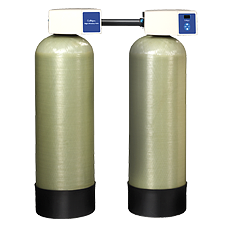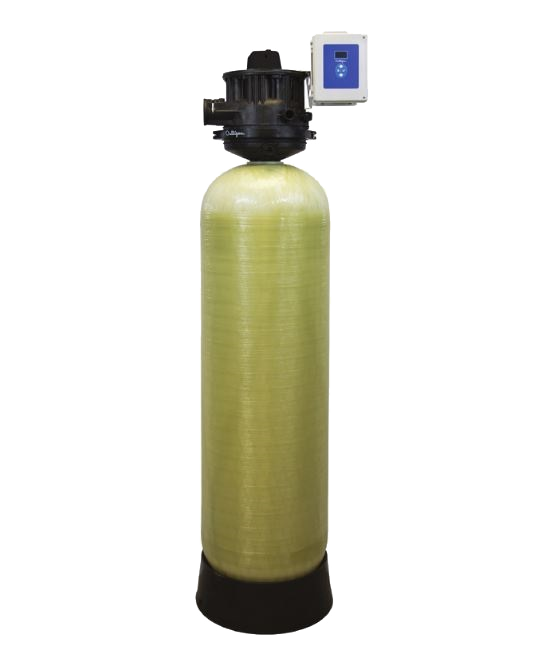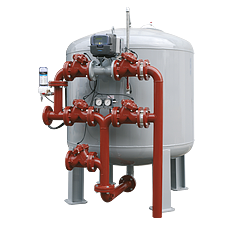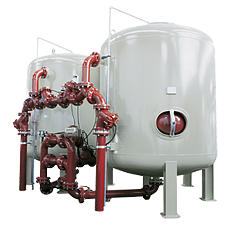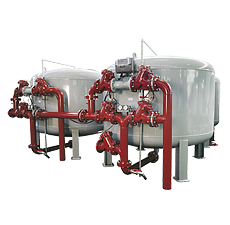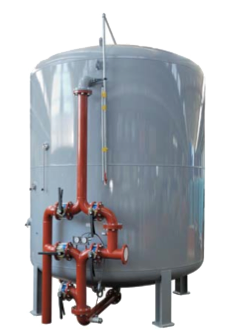Media Filtration






Culligan’s Media Filtration Systems
Culligan utilises pressure tank filtration whereby water is transferred into the filters and passes down through the bed of filtration media where it is filtered and contaminants are removed. Media is selected based on the contaminants present in the water. Learn more about Culligan’s Media Filtration Products.
Culligan’s Pressure filtration technology allows much higher filtration speeds (filtration velocity m/s) than older, more traditional filtration methods such as gravity filtration.
Utilising patented Culligan Multi-Media filtration technology for turbidity / suspended solids removal. Multi-media utilises filtration media of different sizes rather than a single sand layer.
Advantages of the Culligan Multi-Media System Design:
Culligan Media: Solutions for all types of problem water
Turbidity is a measure of water clarity. Turbid water can look cloudy or opaque and can also affect the colour of the water.
Material that causes well water to become turbid includes Clay, Silt, Finely dissolved organic and inorganic material & Microorganisms such as bacteria and viruses
The Culligan Solution: Filtr-cleer Media
Utilising Anthracite and silica sand based multi-layer media; Culligan is able to remove high levels of turbidity, suspended solids and even low concentrations of heavy metals.
A common characteristic of water from public systems is the chlorine taste and odour, which is often quite noticeable. This is caused by the chlorine used to disinfect the water to destroy disease-producing bacteria and other harmful organisms that may be in present in water. Another common complaint is the “rotten egg” smell, which is caused by water containing hydrogen sulphide gas (H2S).
The Culligan Solution: Cullar Media
Granulated Activated Carbon (GAC) is used in the removal of chlorine, colour and unpleasant tastes and odours, creating crystal clear and odourless water.
The use of special manufacturing techniques results in highly porous charcoals that have surface areas of 300-2,000 square metres per gram. These huge surface areas present in the activated charcoals adsorb odorous or coloured substances from the water.
Common causes for acidic water are acid rainfall due to atmospheric carbon dioxide and other airborne pollutants, as well as runoff from mining spoils, and decomposition of plant materials. Acidic water can rapid cause corrosion of pipework and fittings.
The Culligan Solution: Cullneu Media
Granular calcium carbonate is used to increase the pH of the water to neutral levels.
Arsenic contamination of groundwater is often due to naturally occurring high concentrations of arsenic in deeper levels of groundwater. A 2007 study found that over 137 million people in more than 70 countries, including the USA and Italy are probably affected by arsenic poisoning of drinking water. Chronic arsenic poisoning results from drinking contaminated well water over a long period of time. The World Health Organisation recommends a limit of 0.01 mg/l of arsenic in drinking water.
The Culligan Solution: Cullax Media
This specific media reduces arsenic levels through the adsorption of arsenic and vanadium
Although iron and manganese are not considered a health concern in terms of drinking water they do cause a number of secondary problems including; aesthetic problems resulting in orange or brown stains in pipework and fixtures, taste issues resulting in a bitter metallic taste, as well as potentially providing a food source for iron consuming bacteria.
The Culligan Solution: Cullsorb Super Iron Media
Culligan use a selective catalytic multi-layer media for the removal of iron and manganese. Oxygenation is utilised prior to the filter, and regeneration of the media is possible using specific chemicals.
Often found in surface water caused by runoff of fertilisers and other products high in nitrogen based nutrients.
The Culligan Solution: Biological Filters
Designed specifically for the removal of ammonia through acceleration nitrification by use of a biomass of aerobic bacteria supported by a layer of quartz-based media. Culligan biofilters can also oxidise and remove low concentrations of iron and manganese.
Culligan’s Media Filtration Products
High Efficiency (HE)
Suitable for light commercial applications, such as the pre-treatment of water for softeners and boilers, with a maximum flow rate of 8.1 m3 / h.
The High Efficiency (HE) filter with patented technology and the Culligan exclusive 1.5” HE valve provides improved efficiency by reducing contaminants that affect equipment performance and durability.
With the Culligan Smart Controller, available on the HE, customers can set-up a single or multiple tank system that adjusts to flow demand.
CTM
deal for flow rates between 3 and 11 m3 / h, the CTM filter utilises a 2 inch top mounted valve on a fiberglass tank.
CTM filter helps meet the challenges of your changing water quality needs at variable consumption levels, reducing solids and contaminants that affect water-using equipment performance and durability.
Using the Culligan-exclusive Smart Controller you can efficiently manage your water quality.
HiFlo6
The HiFlo6 filter is ideal for Industrial and municipal water users. With capacities between 36 and 170 m3 / h.
Longevity is assured through use of an internally epoxy-painted high grade carbon steel tank.
Available in a modular twin and quad configuration, systems can be configured and connected based on your requirements, adding tanks as your usage increases
Hi-Flo 9
The HiFlo9 water filters are ideal for Industrial and municipal water users.
The HiFlo9 water filters can be specified with media designed to reduce suspended solids, chlorine, iron, manganese, arsenic and other contaminants in the water with flow rates ranging from 3 to 105 m3 / h.
These filters are modular in design and can be configured in parallel (twin and Quad formations) or connected in series to allow systems to be scaled up to deal with higher flow rates.
OFSY
The Culligan OFSY (Omni-Filtration System) models offer a fully automated treatment process optimized to provide filtration of feed waters, particularly surface waters with suspended solids and high turbidity levels.
The Two-stage filtration system in series, exclusive Culligan, ideal for removing large quantities (up to 100ppm) of turbidity and suspended solids.
GAC
Granular activated carbon media filters designed to adsorb organic halogen compounds, pesticides, heavy metals and other substances harmful to health.

